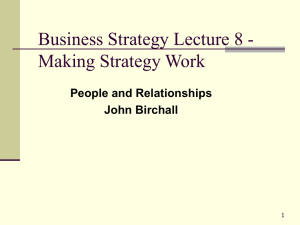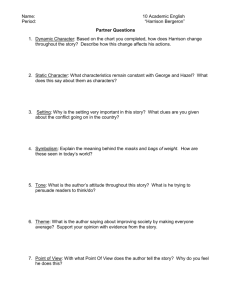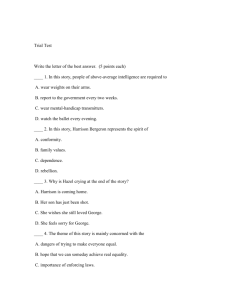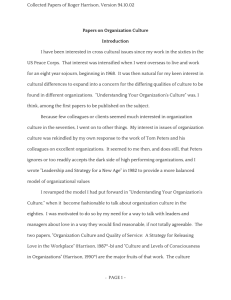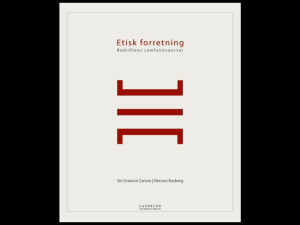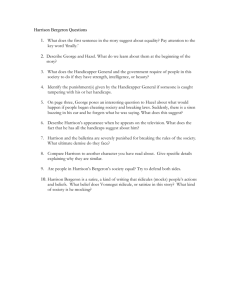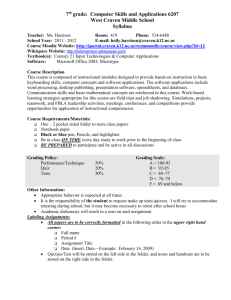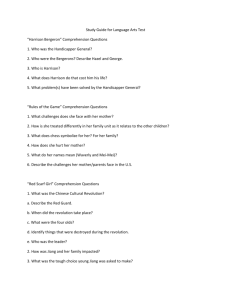Business Strategy Strategic Direction
advertisement
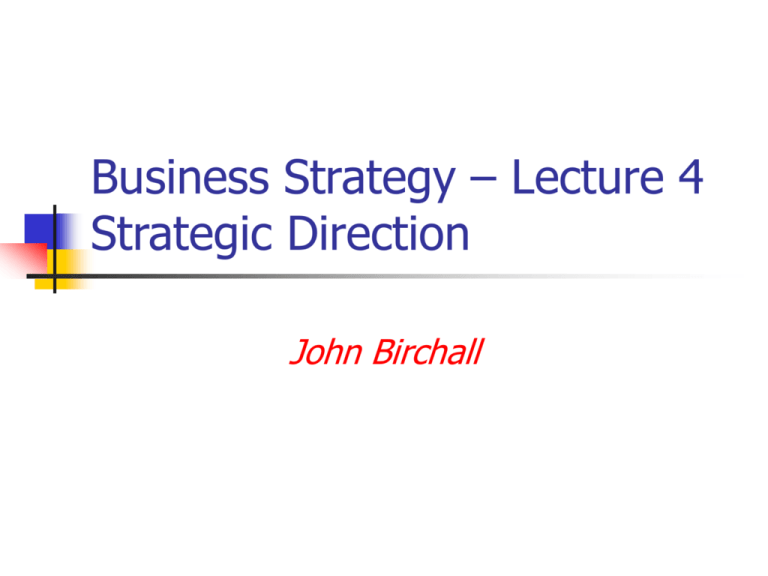
Business Strategy – Lecture 4 Strategic Direction John Birchall Our Focus Today (Harrison 2003: 4) “Strategic management is a process through which organizations analyse and learn from their internal and external environments, establish strategic direction, create strategies that are intended to move the organization in that direction, and implement those strategies, all in an effort to satisfy key stakeholders” Linking Purpose to Action Strategy Context Broad and Operating Environments Organisational Purpose Vision, Mission, Ethics Strategy Process Involves Stakeholders Strategy Content Business Definition, Competitive Strategies Adapted from Harrison (2003: 37) and De Wit & Meyer (2005: 5) Mission and Purpose Why does the organisation exist? survive, serve, make profits, have fun? Nokia example (Harrison 2003: 118-9) Making the most of digital opportunities Aiming for the next wave of growth and innovation Looking after the environment Providing safety and inspiration for staff Achieving financial benefits Gaining stakeholder acceptance Beyond the Balance Sheet: Corporate Integrity Jeffrey Immelt CEO General Electric (since 2001) General Electric (GE website Oct 2007) No mission statement: operating philosophy & business objectives stated each year in letter to shareowners, employees and customers in the annual report. GE Values: Imagine Solve Build Lead “Imagination must be practiced within the boundaries of ethics, compliance and integrity” Citizenship: Every day, the people of GE seek to improve the world in which we live. Our Culture: GE has many businesses, but one culture. GE culture develops leaders, offers diverse & rewarding work environment, supports employees’ voluntary work Stakeholder Influences on Strategic Direction The Operating Environment Activist Groups Suppliers Unions Competitors Local Communities Owners Directors The Organization Managers Financial Intermediaries Employees Customers The Media Government Agencies and Administrators Harrison (2003: 37) Stakeholder Analysis Freeman (1984) Strategic Management: A Stakeholder Approach Donaldson and Preston (1995) The Stakeholder Theory of the Corporation: Concepts, Evidence and Implications AMR Freeman, Harrison & Wicks (2007) Managing for Stakeholders Classify rather than simply list Internal / Connected / External Positive / Negative Power / Influence Interest: Nature / Intensity The Mendelow Grid LEVEL OF INTEREST Low Minimal effort Keep informed High Keep satisfied Key players POWER Low High Johnson, Scholes and Whittington (2005: 182), citing Mendelow (1991) Organisational structure The legacy of past success The Icarus paradox Can create inertia (Harrison 2003: 120) ‘Do nothing’ is often a preferred option Comfort, stability, security are valued Ideology influences vision and mission Bounded rationality The Risk of Strategic Drift Environmental change Amount of change 5 3 2 1 Phase 1 Incremental change Jump 5 Strategic innovation Strategic change 4 Time Phase 3/4 Phase 2 Transformational Flux change or demise Expecting the Unexpected Mintzberg (1987:14) Intended Strategy Imposed Strategy Unrealised Strategy Emergent Strategy Realised strategy Feedback loops (Harrison 2003: 121) Freeing the firm from bounded rationality Broad Environment Feedback that Guides Impressions, Expectations and Behavior External Stakeholders Strategic Direction Vision Mission Business Definition Growth Orientation Organizational Ethics Internal Stakeholders History and Inertia Organizational Actions Organizational Outcomes Feedback that Guides Impressions, Expectations and Behavior Strategic Direction Must be clear and firm – yet open to change Statements of vision, values, mission: Make paradigms public, therefore open to question and transformation Business definition (Harrison 2003: 124) Explains how the organisation wants to make its vision work Whose needs are being served? What is to be produced, or what services delivered - and how? Strategic Decisions Will commit a substantial share of the organisation’s resources in the medium or long term Can affect the firm’s overall scale and scope How big relative to competitors? How heavily focused on specific industries? How much control of the industry supply chain? Can change the pattern of relationships with key stakeholders Strategic Direction Now, you can begin to; Identify stakeholder groups Assess their influence on strategy Explain what paradigms are and how they change Link organisational purpose to action
